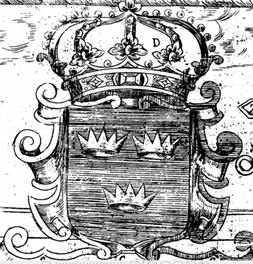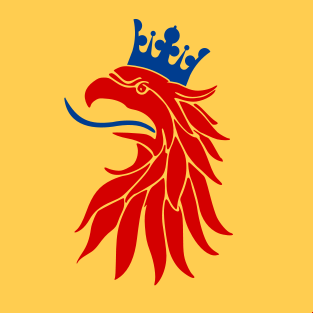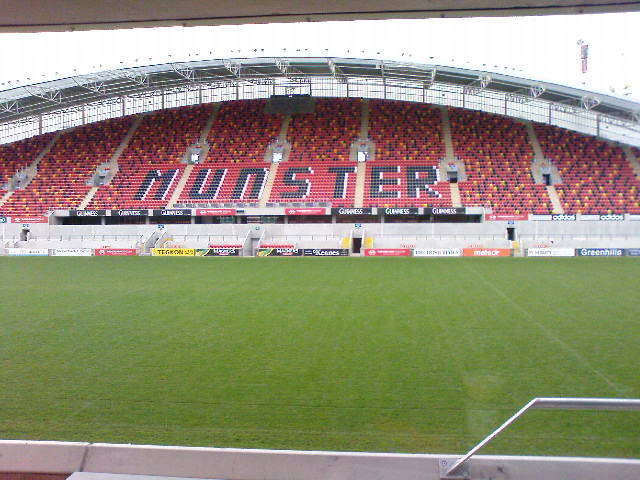|
Flag Of Munster
The coat of arms of Munster consists of three gold crowns on a blue field. Similar crowns were included on the arms of Ireland before being superseded by the golden harp in the 16th century. The meaning of the three crowns is not certain, but one possibility is that they may represent three of the medieval Hiberno-Norman lordships in Munster; the O'Briens (Thomond), the Butlers ( Ormond) and the Fitzgeralds ( Desmond). Other sources suggest that the arms (''dark blue, three antique crowns Or'') are derived from the short-lived dukedom of Ireland created for Robert de Vere in 1386. Further sources suggest that the crown motif dates to the earlier Kingdom of Munster, based on a thirteenth-century crozier head which was decorated with a crown on a blue enamel surface and found near the Rock of Cashel, the seat of the Gaelic Irish Kings of Munster. The crowns are usually depicted as "antique" or "eastern": a gold rim with eight sharp, triangular rays, of which five are seen. ... [...More Info...] [...Related Items...] OR: [Wikipedia] [Google] [Baidu] |
Banner Of Arms
A banner of arms is a type of heraldic flag which has the same image as a coat of arms, ''i.e.'' the shield of a full achievement (heraldry), heraldic achievement, rendered in a square or rectangular shape of the flag. The term is derived from the terminology of heraldry but mostly used in vexillology. Examples of modern national flags which are banners of arms are the flags of Flag of Austria, Austria, Flag of Iraq, Iraq, and Flag of Switzerland, Switzerland. The banner of arms is sometimes simply called a banner, but a banner is in a more strict sense a one of a kind personal flag of a nobleman held in battle. Examples National flags Subdivision flags County flags City flags Organization flags References External links * {{Heraldry Types of flags ... [...More Info...] [...Related Items...] OR: [Wikipedia] [Google] [Baidu] |
Provinces Of Ireland
There have been four Provinces of Ireland: Connacht (Connaught), Leinster, Munster, and Ulster. The Irish language, Irish word for this territorial division, , meaning "fifth part", suggests that there were once five, and at times Kingdom_of_Meath, Meath has been considered to be the fifth province; in the medieval period, however, there were often more than five. The number of provinces and their delimitation fluctuated until 1610, when they were permanently set by the English administration of James VI and I, James I. The provinces of Ireland no longer serve administrative or political purposes but function as historical and cultural entities. Etymology In modern Irish language, Irish the word for province is (pl. ). The modern Irish term derives from the Old Irish (pl. ) which literally meant "a fifth". This term appears in 8th-century law texts such as and in the legendary tales of the Ulster Cycle where it refers to the five kingdoms of the "Pentarchy". MacNeill enumer ... [...More Info...] [...Related Items...] OR: [Wikipedia] [Google] [Baidu] |
Royal Society Of Antiquaries Of Ireland
The Royal Society of Antiquaries of Ireland is a learned society based in Ireland, whose aims are "to preserve, examine and illustrate all ancient monuments and memorials of the arts, manners and customs of the past, as connected with the antiquities, language, literature and history of Ireland". Founded in 1849, it has a countrywide membership from all four provinces of Ireland. Anyone subscribing to the aims of the Society, subject to approval by Council, may be elected to membership. Current and past members have included historians, archaeologists and linguists, but the Society firmly believes in the importance of encouraging an informed general public, and many members are non-professionals. After the Society's move to Dublin in the 1890s, it came eventually to occupy the premises on Merrion Square, where it is still to be found. It now fulfills its original aims through the maintenance of its library and provision of lectures and excursions, as well as the continued publi ... [...More Info...] [...Related Items...] OR: [Wikipedia] [Google] [Baidu] |
Ireland Men's National Field Hockey Team
The Ireland men's national field hockey team is organised by Hockey Ireland and represents both the Republic of Ireland and Northern Ireland in international men's field hockey competitions, including the Summer Olympics, the Men's Hockey World Cup and the EuroHockey Nations Championship. They have previously competed in the Men's Intercontinental Cup, the Hockey Champions Challenge, the Men's FIH Hockey World League and the FIH Hockey Series. On 26 January 1895 Ireland played in the first ever international field hockey match when they defeated Wales 3–0 in Rhyl. Ireland were finalists and silver medallists at the 1908 Summer Olympics. Ireland were also bronze medallists at the 2015 Men's EuroHockey Nations Championship. Early years The Irish Hockey Union was founded on 6 February 1893 and on 26 January 1895 Ireland played in the first ever international field hockey match when they defeated Wales 3–0 in Rhyl. In 1895 Ireland also played England for the first time. This ... [...More Info...] [...Related Items...] OR: [Wikipedia] [Google] [Baidu] |
Irish Rugby Football Union
The Irish Rugby Football Union (IRFU) ( ga, Cumann Rugbaí na hÉireann) is the body managing rugby union in the island of Ireland (both Republic of Ireland and Northern Ireland). The IRFU has its head office at 10/12 Lansdowne Road and home ground at Aviva Stadium, where adult men's Irish rugby union international matches are played. In addition, the Union also owns the Ravenhill Stadium in Belfast, Thomond Park in Limerick and a number of grounds in provincial areas that have been rented to clubs. History Initially, there were two unions: the Irish Football Union, which had jurisdiction over clubs in Leinster, Munster and parts of Ulster and was founded in December 1874, and the Northern Football Union of Ireland, which controlled the Belfast area and was founded in January 1875. The IRFU was formed in 1879 as an amalgamation of these two organisations and branches of the new IRFU were formed in Leinster, Munster and Ulster. The Connacht Branch was formed in 1900. The IR ... [...More Info...] [...Related Items...] OR: [Wikipedia] [Google] [Baidu] |
Four Provinces Flag Of Ireland
The following is a list of Irish counties' coats of arms. In the majority of cases these are arms assigned to county councils created by the Local Government (Ireland) Act 1898 or later legislation, either by the Chief Herald of Ireland in what is now the Republic of Ireland or by the College of Arms in Northern Ireland. All but two county councils in the Republic have a coat of arms. In Northern Ireland county councils were abolished in 1973, but the traditional arms are still occasionally used. The arms of the county town have sometimes been used as an unofficial symbol of a county instead of those of its county council, or when the council had no arms. There are no official county flags. Flags with the GAA county colours serve as de facto county flags. County flags flown at Dublin Castle incorporate the county council arms, while those sold by the GAA county board include the county GAA crest. Coats of arms granted in recent decades often incorporate the GAA colours in the field. ... [...More Info...] [...Related Items...] OR: [Wikipedia] [Google] [Baidu] |
Connacht
Connacht ( ; ga, Connachta or ), is one of the provinces of Ireland, in the west of Ireland. Until the ninth century it consisted of several independent major Gaelic kingdoms (Uí Fiachrach, Uí Briúin, Uí Maine, Conmhaícne, and Delbhna). Between the reigns of Conchobar mac Taidg Mór (died 882) and his descendant, Aedh mac Ruaidri Ó Conchobair (reigned 1228–33), it became a kingdom under the rule of the Uí Briúin Aí dynasty, whose ruling sept adopted the surname Ua Conchobair. At its greatest extent, it incorporated the often independent Kingdom of Breifne, as well as vassalage from the lordships of western Mide and west Leinster. Two of its greatest kings, Tairrdelbach Ua Conchobair (1088–1156) and his son Ruaidri Ua Conchobair (c. 1115–1198) greatly expanded the kingdom's dominance, so much so that both became High King of Ireland. The Kingdom of Connacht collapsed in the 1230s because of civil war within the royal dynasty, which enabled widespread Hiber ... [...More Info...] [...Related Items...] OR: [Wikipedia] [Google] [Baidu] |
Ulster
Ulster (; ga, Ulaidh or ''Cúige Uladh'' ; sco, label= Ulster Scots, Ulstèr or ''Ulster'') is one of the four traditional Irish provinces. It is made up of nine counties: six of these constitute Northern Ireland (a part of the United Kingdom); the remaining three are in the Republic of Ireland. It is the second-largest (after Munster) and second-most populous (after Leinster) of Ireland's four traditional provinces, with Belfast being its biggest city. Unlike the other provinces, Ulster has a high percentage of Protestants, making up almost half of its population. English is the main language and Ulster English the main dialect. A minority also speak Irish, and there are Gaeltachtaí (Irish-speaking regions) in southern County Londonderry, the Gaeltacht Quarter, Belfast, and in County Donegal; collectively, these three regions are home to a quarter of the total Gaeltacht population of Ireland. Ulster-Scots is also spoken. Lough Neagh, in the east, is the largest lake i ... [...More Info...] [...Related Items...] OR: [Wikipedia] [Google] [Baidu] |
Leinster
Leinster ( ; ga, Laighin or ) is one of the provinces of Ireland, situated in the southeast and east of Ireland. The province comprises the ancient Kingdoms of Meath, Leinster and Osraige. Following the 12th-century Norman invasion of Ireland The Anglo-Norman invasion of Ireland took place during the late 12th century, when Anglo-Normans gradually conquered and acquired large swathes of land from the Irish, over which the kings of England then claimed sovereignty, all allegedly sanc ..., the historic provinces of Ireland, "fifths" of Leinster and Meath gradually merged, mainly due to the impact of the Pale, which straddled both, thereby forming the present-day province of Leinster. The ancient kingdoms were shired into a number of counties of Ireland#2.1 Pre-Norman sub-divisions, counties for administrative and judicial purposes. In later centuries, local government legislation has prompted further sub-division of the historic counties. Leinster has no official funct ... [...More Info...] [...Related Items...] OR: [Wikipedia] [Google] [Baidu] |
Munster Rugby
Munster Rugby ( ga, Rugbaí Mumhan) is one of the four professional provincial rugby teams from the island of Ireland. They compete in the United Rugby Championship and the European Rugby Champions Cup. The team represents the IRFU's Munster Branch, which is responsible for rugby union throughout the Irish province of Munster. The team motto is "To the brave and faithful, nothing is impossible." This is derived from the motto of the MacCarthy clan – "Forti et Fideli nihil difficile". Their main home ground is Thomond Park, Limerick, though some games are played at Musgrave Park, Cork. History Foundation and early years Munster was officially founded in 1879, at the same time as Leinster and Ulster, with Connacht being founded ten years later in 1889. The first interprovincial matches between Leinster, Ulster and Munster, however, were held in 1875. The founding of the Munster branch of the IRFU was intended to organise and oversee the game within the province and prevent ... [...More Info...] [...Related Items...] OR: [Wikipedia] [Google] [Baidu] |
Munster GAA
The Munster Council is a provincial council of the Gaelic Athletic Association sports of hurling, Gaelic football, camogie, rounders and handball in the province of Munster. County boards *Cork * Clare *Kerry *Limerick *Tipperary *Waterford Hurling Provincial team The Munster provincial hurling team represents the province of Munster in hurling. The team competes in the Railway Cup. Honours *Railway Cups: 46 **1928, 1929, 1930, 1931, 1934, 1937, 1938, 1939, 1940, 1942, 1943, 1944, 1945, 1946, 1948, 1949, 1950, 1951, 1952, 1953, 1955, 1957, 1958, 1959, 1960, 1961, 1963, 1966, 1968, 1969, 1970, 1976, 1978, 1981, 1984, 1985, 1992, 1995, 1996, 1997, 2000, 2001, 2005, 2007, 2013, 2016 Current panel Players Players from the following county teams represent Munster: Clare, Cork, Kerry, Limerick, Tipperary and Waterford. =Notable players= Competitions Inter-county ;Record *All-Ireland Senior Hurling Championships: 72 **Cork: 1890, 1892, 1893, 1 ... [...More Info...] [...Related Items...] OR: [Wikipedia] [Google] [Baidu] |
Mór Muman
Mór Muman or Mór Mumain (modern spelling: Mór Mhumhan) is a figure from early Irish literature who is said to have been a queen of Munster and daughter of king Áed Bennán. Her name means "the Great Mother" and the province of Munster (''An Mhumhain'') is named after her.Olmsted, Garrett. ''The gods of the Celts and the Indo-Europeans''. University of Innsbruck, 1994. pp.162, 206, 270 She is believed to be an euhemerised mother goddess and sovereignty goddess of the province, particularly of the Eóganachta.MacKillop, "Mór Muman". Mór Muman "personifies the land of Munster" and "the sovereignty of the region".Lysaght, Patricia, "Traditions of the Banshee", in Miranda Green & Sandra Billington (ed.), ''The Concept of the Goddess''. Psychology Press, 1996. p.158 She is also known as Mugain and may be the same figure as Anu and the Morrígan. Traditions The Irish-language tale ''Mór Muman 7 Aided Cuanach meic Ailchine'' ("Mór Muman and the death of Cuanu mac Ailchine") is found ... [...More Info...] [...Related Items...] OR: [Wikipedia] [Google] [Baidu] |




.jpg)



_-_Railway_Cup_2008.jpg)